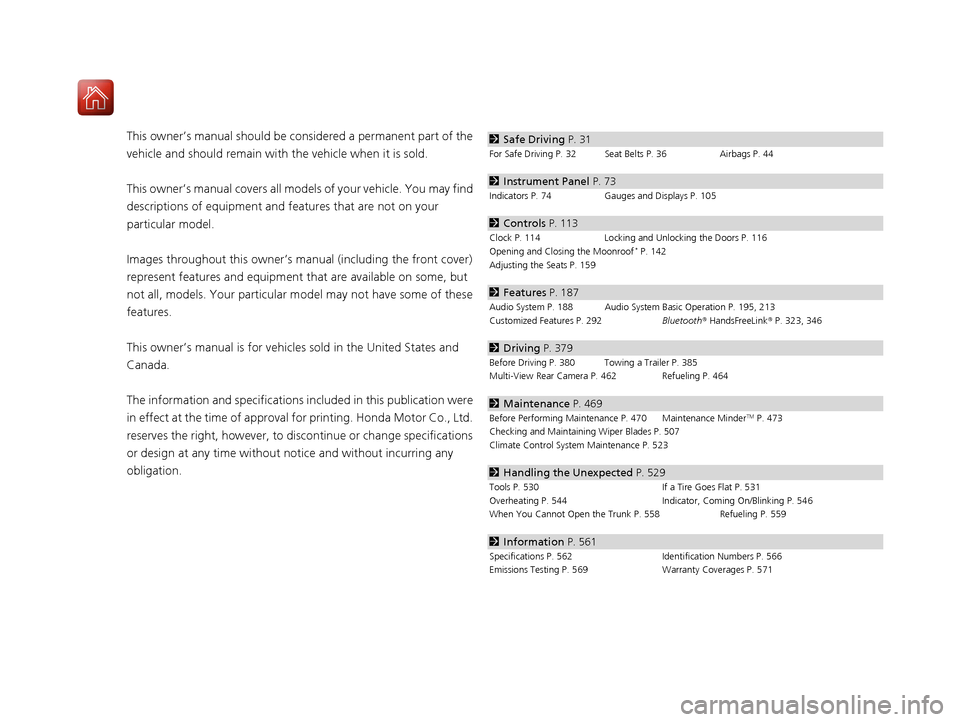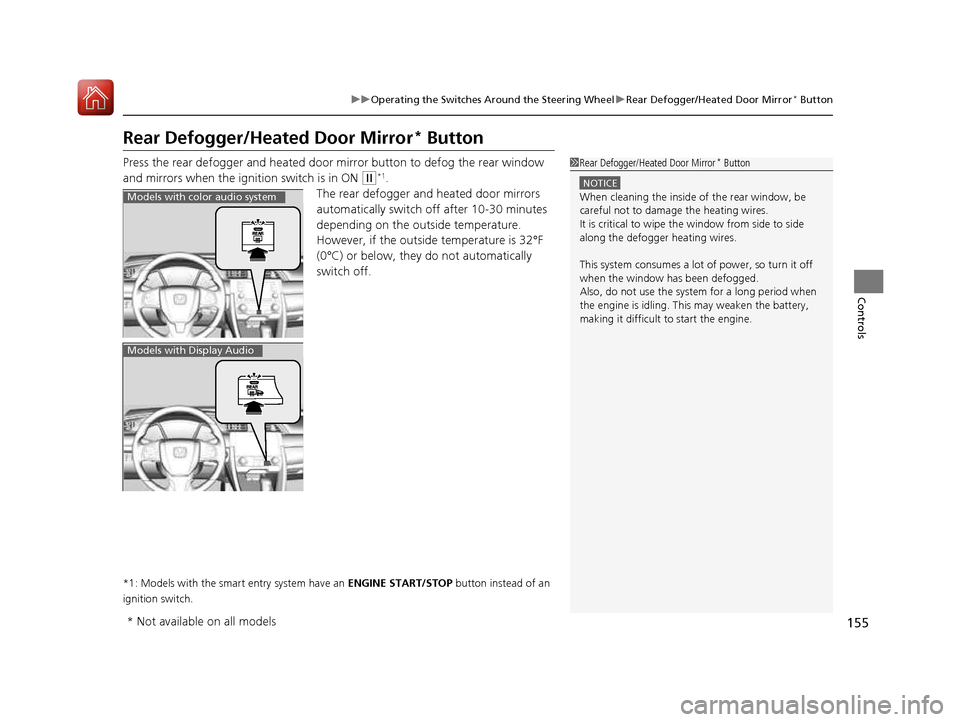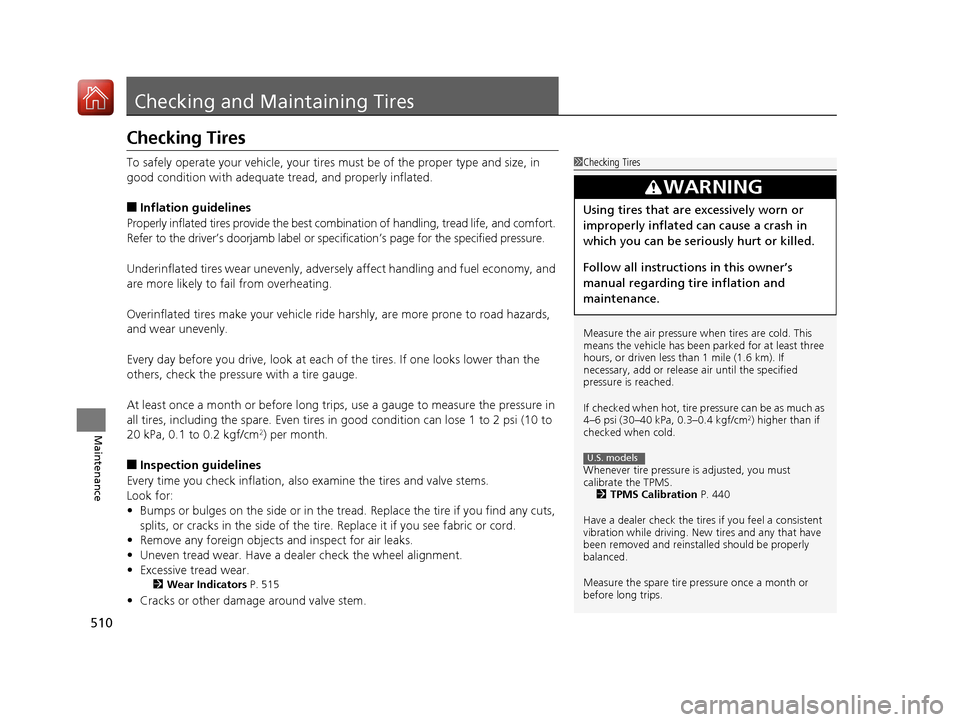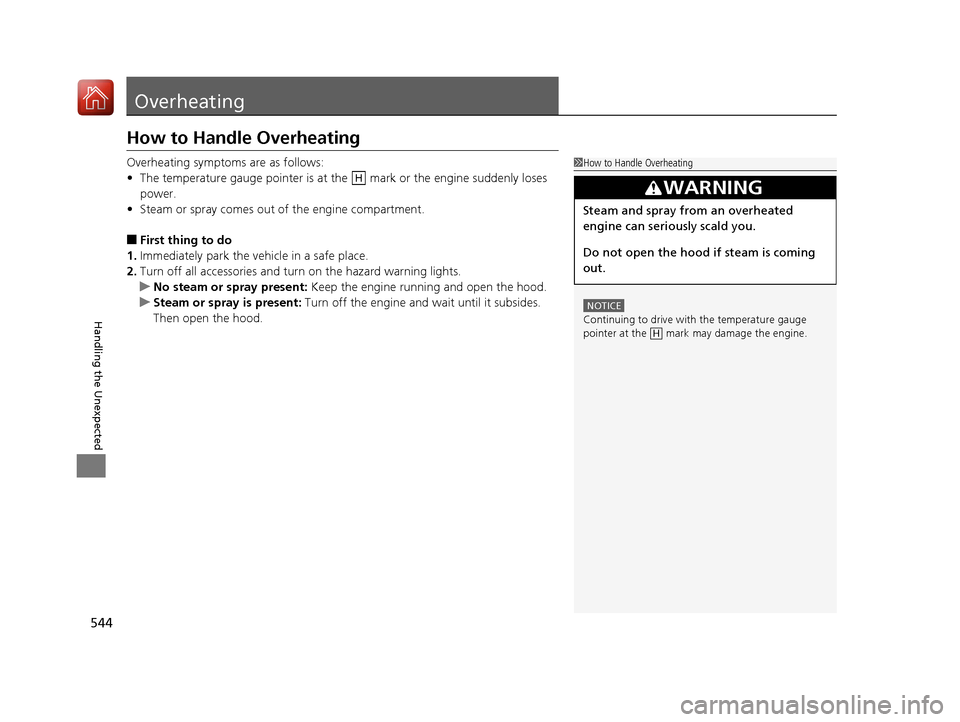2016 HONDA CIVIC COUPE heating
[x] Cancel search: heatingPage 3 of 585

Contents
This owner’s manual should be considered a permanent part of the
vehicle and should remain with the vehicle when it is sold.
This owner’s manual covers all models of your vehicle. You may find
descriptions of equipment and features that are not on your
particular model.
Images throughout this owner’s manual (including the front cover)
represent features and equipment that are available on some, but
not all, models. Your particular mo del may not have some of these
features.
This owner’s manual is for vehicles sold in the United States and
Canada.
The information and specifications in cluded in this publication were
in effect at the time of approval for printing. Honda Motor Co., Ltd.
reserves the right, however, to discontinue or change specifications
or design at any time without notice and without incurring any
obligation.2 Safe Driving P. 31
For Safe Driving P. 32 Seat Belts P. 36 Airbags P. 44
2Instrument Panel P. 73
Indicators P. 74 Gauges and Displays P. 105
2Controls P. 113
Clock P. 114 Locking and Unlocking the Doors P. 116
Opening and Closing the Moonroof *
P. 142
Adjusting the Seats P. 159
2 Features P. 187
Audio System P. 188 Audio System Basic Operation P. 195, 213
Customized Features P. 292 Bluetooth® HandsFreeLink ® P. 323, 346
2 Driving P. 379
Before Driving P. 380 Towing a Trailer P. 385
Multi-View Rear Camera P. 462 Refueling P. 464
2Maintenance P. 469
Before Performing Maintenance P. 470 Maintenance MinderTM
P. 473
Checking and Maintaining Wiper Blades P. 507 Climate Control System Maintenance P. 523
2Handling the Unexpected P. 529
Tools P. 530 If a Tire Goes Flat P. 531
Overheating P. 544 Indicator, Coming On/Blinking P. 546
When You Cannot Open the Trunk P. 558 Refueling P. 559
2Information P. 561
Specifications P. 562 Identi fication Numbers P. 566
Emissions Testing P. 569 Warranty Coverages P. 571
16 CIVIC 2D HC2 (0A 01 0C)-31TBG6000.book 2 ページ >0>.>/6年>0月>/>0日 金曜日 午後4時>/6分
Page 28 of 585

Quick Reference Guide
27
Handling the Unexpected
(P 529)
Flat Tire (P 531)
● Park in a safe location and replace the
flat tire with the comp act spare tire in the
trunk.
Indicators Come On
(P 546) ● Identify the indica tor and consult the
owner's manual.
Engine Won’t Start
(P 537) ● If the battery is dead, jump start using a
booster battery.
Blown Fuse (P 552)
● Check for a blown fuse if an electrical
device does not operate.Overheating (P 544)
● Park in a safe location. If you do not see
steam under the hood, open the hood,
and let the engine cool down.
Emergency Towing
(P 556) ● Call a professional towing service if you
need to tow your vehicle.
* Not available on all models
16 CIVIC 2D HC2 (0A 01 0C)-31TBG6000.book 27 ページ >0>.>/6年>0月>/>0日 金 曜日 午後4時>/6分
Page 106 of 585

105
Instrument Panel
Gauges and Displays
Gauges
Gauges include the speedometer, tachometer, fuel gauge, and related indicators.
They are displayed when the ignition switch is in ON
(w*1
.
Displays your driving speed in mph or km/h.
Shows the number of engine revolutions per minute.
Displays the amount of fuel left in the fuel tank.
Displays the temperature of the engine coolant.
*1: Models with the smart entry system have an ENGINE START/STOP button instead of an
ignition switch.
■Speedometer
■Tachometer
■Fuel Gauge
■Temperature Gauge
1Gauges
Press and hold the km/mil e change knob until you
hear a beep. The speedometer reading and the
displayed measurements switch between mph and
km/h.
Press the (display /information) button
repeatedly until the ic on is shown on the driver
information interface. Press ENTER, then press and
hold it again. The spee dometer reading and the
displayed measurements wi ll switch between mph
and km/h.
Models with information display
Models with driver information interface
1Fuel Gauge
NOTICE
You should refuel when the reading approaches . Running out of fuel can cause the engine to misfire,
damaging the cata lytic converter.
The actual amount of remain ing fuel may differ from
the fuel gauge reading.E
1Temperature Gauge
NOTICE
Driving with the temperat ure gauge pointer in the
upper zone can cause serious engine damage. Pull
safely to the side of th e road and allow engine
temperature to return to normal. 2 Overheating P. 544
16 CIVIC 2D HC2 (0A 01 0C)-31TBG6000.book 105 ページ >0>.>/6年>0月>/>0日 金曜日 午後4時>/6分
Page 156 of 585

155
uuOperating the Switches Around the Steering WheeluRear Defogger/Heated Door Mirror*
Button
Controls
Rear Defogger/Heated Door Mirror *
Button
Press the rear defogger and heated door mirror button to defog the rear window
and mirrors when the ignition switch is in ON
(w *1
.
The rear defogger and heated door mirrors
automatically switch of f after 10-30 minutes
depending on the outside temperature.
However, if the outsid e temperature is 32°F
(0°C) or below, they do not automatically switch off.
*1: Models with the smart entry system have an ENGINE START/STOP button instead of an
ignition switch.
1Rear Defogger/Heated Door Mirror *
Button
NOTICE
When cleaning the inside of the rear window, be
careful not to damage the heating wires.
It is critical to wipe th e window from side to side
along the defogger heating wires.
This system consumes a lot of power, so turn it off
when the window has been defogged.
Also, do not use the system for a long period when
the engine is idling. This may weaken the battery, making it difficult to start the engine.Models with color audio system
Models with Display Audio
* Not available on all models
16 CIVIC 2D HC2 (0A 01 0C)-31TBG6000.book 155 ページ >0>.>/6年>0月>/>0日 金曜日 午後4時>/6分
Page 511 of 585

510
Maintenance
Checking and Maintaining Tires
Checking Tires
To safely operate your vehicle, your tires must be of the proper type and size, in
good condition with adequate tread, and properly inflated. ■Inflation guidelines
Properly inflated tires provide the best combination of handling, tread life, and comfort.
Refer to the driver’s doorjamb label or spec ification’s page for the specified pressure.
Underinflated tires wear unevenly, adversely affect handling and fuel economy, and
are more likely to fail from overheating.
Overinflated tires make your vehicle ride harshly, are more prone to road hazards,
and wear unevenly.
Every day before you drive, look at each of the tires. If one looks lower than the
others, check the pressure with a tire gauge.
At least once a month or before long trips, use a gauge to measure the pressure in
all tires, including the spare. Even tires in good condition can lose 1 to 2 psi (10 to
20 kPa, 0.1 to 0.2 kgf/cm 2
) per month.
■ Inspection guidelines
Every time you check inflation, also examine the tires and valve stems.
Look for:• Bumps or bulges on the side or in the tread. Replace the tire if you find any cuts,
splits, or cracks in the si de of the tire. Replace it if you see fabric or cord.
• Remove any foreign objects and inspect for air leaks.
• Uneven tread wear. Have a deal er check the wheel alignment.
• Excessive tread wear.
2 Wear Indicators P. 515
• Cracks or other damage around valve stem.
1Checking Tires
Measure the air pressure when tires are cold. This
means the vehicle has been parked for at least three
hours, or driven less than 1 mile (1.6 km). If necessary, add or releas e air until the specified
pressure is reached.
If checked when hot, tire pressure can be as much as
4–6 psi (30–40 kPa, 0.3–0.4 kgf/cm 2
) higher than if
checked when cold.
Whenever tire pressure is adjusted, you must
calibrate the TPMS. 2 TPMS Calibration P. 440
Have a dealer check the tires if you feel a consistent
vibration while driving. Ne w tires and any that have
been removed and reinst alled should be properly
balanced.
Measure the spare tire pressure once a month or before long trips.
3WARNING
Using tires that are excessively worn or
improperly inflated can cause a crash in
which you can be seriously hurt or killed.
Follow all instruction s in this owner’s
manual regarding ti re inflation and
maintenance.
U.S. models
16 CIVIC 2D HC2 (0A 01 0C)-31TBG6000.book 510 ページ >0>.>/6年>0月>/>0日 金曜日 午後4時>/6分
Page 530 of 585

529
Handling the UnexpectedThis chapter explains how to handle unexpected troubles.
ToolsTypes of Tools .................................. 530
If a Tire Goes Flat
Changing a Flat Tire ......................... 531
Engine Does Not Start
Checking the Engine ........................ 537
If the Smart Entry Remote Battery is Weak .......................................... 538
Emergency Engine Stop ................... 539
Jump Starting .................................... 540
Shift Lever Does Not Move .............. 543
Overheating
How to Handle Overheating ............. 544 Indicator, Coming On/Blinking
If the Low Oil Pressure Indicator Comes On ............................................. 546
If the Charging System Indicator Comes On ................................................. 546
If the Malfunction Indicator Lamp Comes
On or Blinks ................................... 547
If the Brake System Indicator (Red) Comes
On or Blinks ................................... 548
If the Brake System Indicator (Red) Comes On or Blinks at the Same Time When the
Brake System Indicator (Amber) Comes
On ................................................. 549 If the Electric Power Steering (EPS) System
Indicator Comes On ....................... 550
If the Low Tire Pressure/TPMS Indicator Comes On or Blinks ....................... 551
Fuses Fuse Locations ................................. 552
Inspecting and Changing Fuses ........ 555
Emergency Towing ........................... 556
When You Cannot Unlock the Fuel Fill Door ................................................. 557
When You Cannot Open the Trunk.....558
Refueling ........................................... 559
16 CIVIC 2D HC2 (0A 01 0C)-31TBG6000.book 529 ページ >0>.>/6年>0月>/>0日 金曜日 午後4時>/6分
Page 545 of 585

544
Handling the Unexpected
Overheating
How to Handle Overheating
Overheating symptoms are as follows: •The temperature gauge pointer is at the mark or the engine suddenly loses
power.
• Steam or spray comes out of the engine compartment.
■ First thing to do
1. Immediately park the vehicle in a safe place.
2. Turn off all accessories and turn on the hazard warning lights.
uNo steam or spray present: Keep the engine running and open the hood.
uSteam or spray is present: Turn off the engine and wait until it subsides.
Then open the hood.
1How to Handle Overheating
NOTICE
Continuing to drive with the temperature gauge
pointer at the mark may damage the engine.
3WARNING
Steam and spray from an overheated
engine can seriously scald you.
Do not open the hood if steam is coming
out.
H
H
16 CIVIC 2D HC2 (0A 01 0C)-31TBG6000.book 544 ページ >0>.>/6年>0月>/>0日 金曜日 午後4時>/6分
Page 546 of 585

545
uuOverheatinguHow to Handle Overheating
Handling the Unexpected
■Next thing to do
1.Check that the cooling fan is operating and
stop the engine once the temperature
gauge pointer comes down.
uIf the cooling fan is not operating,
immediately stop the engine.
2. Once the engine has cooled down, inspect
the coolant level and check the cooling
system components for leaks.
uIf the coolant level in the reserve tank is
low, or no coolant in the tank, check that
the radiator is cool. Cover the reserve
tank cap with a heavy cloth and open the
cap. Add coolant until it reaches the MAX mark, and put the cap back on.
■ Last thing to do
Once the engine has cooled sufficiently, restart it and check the temperature gauge.
If the temperature gauge pointer has gone down, resume driving. If it has not gone
down, contact a dealer for repairs.
1How to Handle Overheating
If the coolant is leaking, contact a dealer for repairs.
Use water as an emergency/temporary measure only.
Have a dealer flush the system with proper antifreeze
as soon as possible.
3WARNING
Removing the reserve tank cap while the
engine is hot can cause the coolant to spray
out, seriously scalding you.
Always let the engine and radiator cool
down before removing the reserve tank
cap.
MAX
Reserve TankMIN
16 CIVIC 2D HC2 (0A 01 0C)-31TBG6000.book 545 ページ >0>.>/6年>0月>/>0日 金曜日 午後4時>/6分